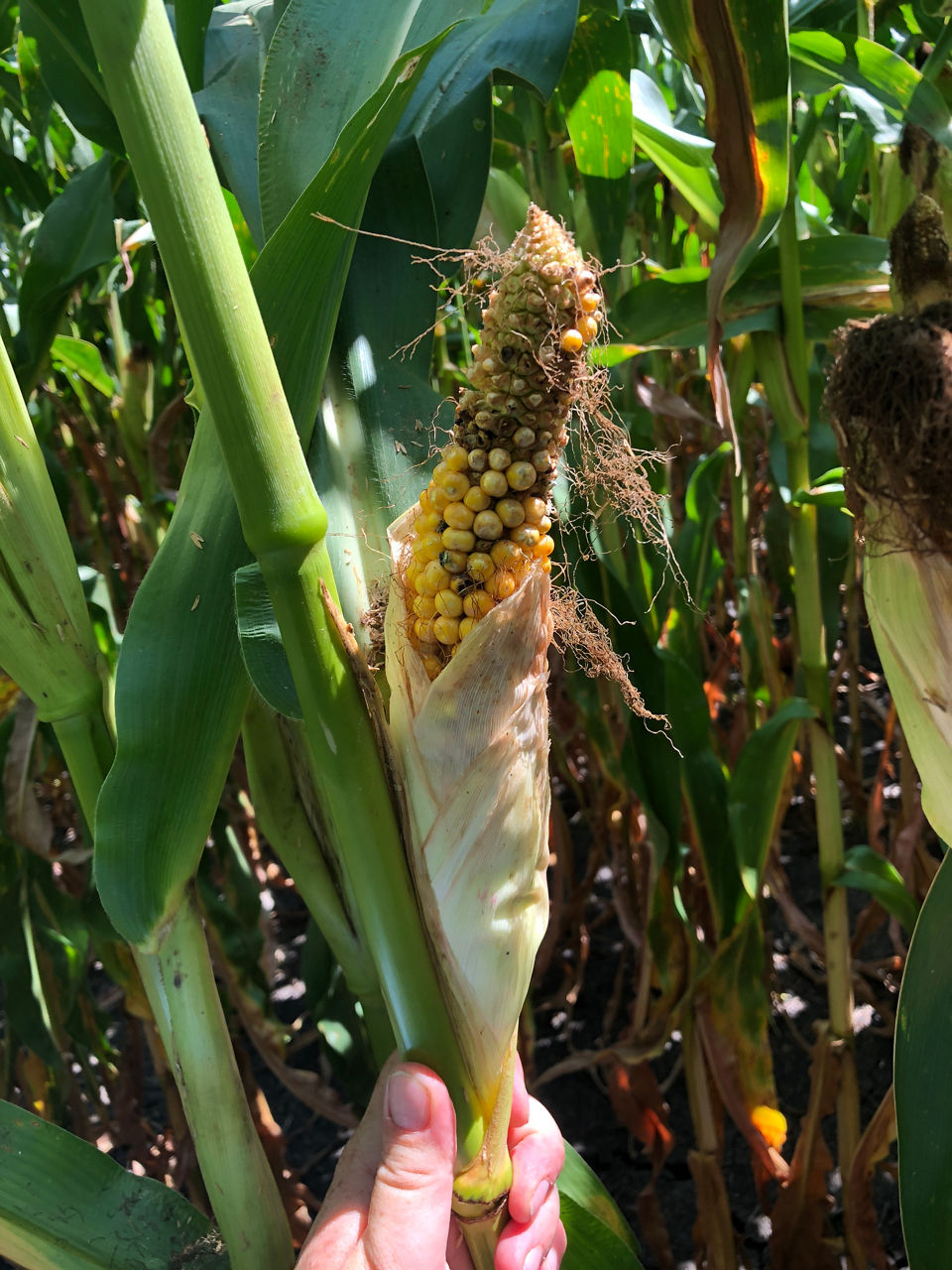3 MIN READ
Short Husks and Exposed Ears During Corn Harvest
November 12, 2019
Q: What can cause husks to be too short to cover the entire ear?
- Crop stress, particularly drought and high heat prior to VT and relieved after VT but prior to the blister stage.1
- Genetics of the individual corn products can have ears that extend beyond the husk, particularly when ample rain occurs during early grain fill.
- In severe cases, the primary ear node may be aborted because of stress and as a result, the secondary ear node becomes the dominate ear.2
Q: How does drought and/or high heat cause husks to shorten?
- Drought and/or high heat just prior to and during pollination can place plants under considerable water stress, which can cause shorter plants, leaves, and husks. Improved environmental conditions (cooler temperatures and ample rainfall) soon after pollination can allow cobs to renew growth and extend beyond the shortened husks (Figure 1), which do not renew growth.1
- Early in plant growth, around V6-V7 growth stages, potential ear girth (number of rows around) is determined while potential ear length (number of kernels/row) is determined around V7-V15/V16 growth stages, giving the cob the potential ability to extend.

Figure 1. Example of a drought-induced shortened husk prior to pollination and post-pollination ear extension after a rain event, Wing, IL Market Development Plot, 2018.
Q: Can other stresses cause this abnormality?
- The symptoms have not been linked to other stress factors such as nutrient deficiencies or herbicide injury. However, roots that are severely injured pre-tassel in combination with drought or high heat has resulted in similar symptoms.1
Q: Can yield or grain quality be reduced?
- When these symptoms are observed, the major cause for any yield reduction is likely a direct result of the drought and high heat conditions. Some yield loss can occur when the exposed kernels are fed upon by birds and insects or damaged by unfavorable weather.
- Overall grain quality can be reduced if mold develops on the exposed kernels and/or the kernels are damaged by insects or birds.
Q: Can symptoms be reduced?
- No management techniques are available during the growing season to help reduce the symptoms.
Q: What can be done prior to planting to help reduce the potential for symptom development?
- Select seed products that have higher ratings for drought tolerance.
- Plant seed products with different relative maturities to help stagger corn development. By doing so, pollination and husk and ear development may occur during a more favorable environment for some of the products.
- Employ techniques to reduce the potential for compaction and/or utilize tillage to break up compaction to reduce root stress.
- If available, timely irrigation can help reduce the impact of drought.
Q: Can the symptoms be observed during favorable growing conditions?
- Some seed products have a genetic potential to extend the cob beyond the husks. Additionally, even under very good pre-tassel conditions, rainfall soon after pollination can cause the cobs to produce extra length. Many times, this appears as unfilled ear tips because pollen was no longer available . The opposite can also be seen where the husks completely cover the ear and surround the ear tightly.
Source:
1Nielsen, R.L. 2018. Short husks & exposed ears. Corny News Network. The Chat ‘n Chew Café. Purdue University. http://www.kingcorn.org/.
2Elmore, R. Rees, J., McMechan, J. Jackson-Ziems, T., and Hoegemeyer, T. 2016. Corn ear formation issues likely correlated with the loss of the primary ear node. CropWatch. University of Nebraska-Lincoln. https://cropwatch.unl.edu/.
Website verified 11/8/19
7002_Q2